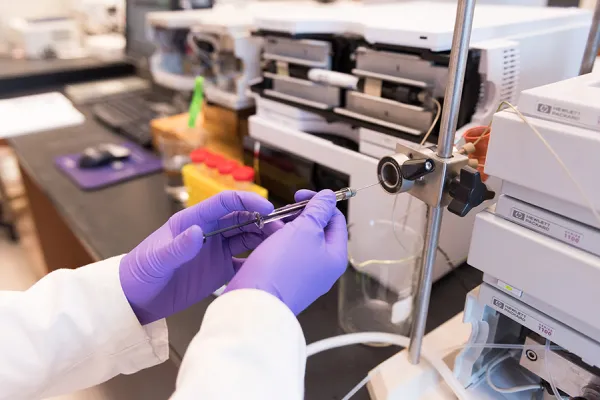Brand-New View: Students Use New Microscope to Advance Cell Research
Research & Inquiry

Published July 28, 2016
To describe her summer research project in Smith professor Nathan Derr’s lab, Amalia Driller-Colangelo ’18 draws a picture of a tiny intracellular motor protein on a white board.
Up until a decade ago, scientists were unable to see such dynein proteins in action because they lacked the optical equipment and techniques needed to observe individual molecules, Driller-Colangelo explains.
Now, thanks to a cutting-edge microscope at Smith’s Center for Microscopy and Imaging, students can actually watch those molecules move.
This summer, Driller-Colangelo and two fellow participants in Smith’s Summer Research Fellowship program (SURF)—Jessica Morgan ’17 and Sahar Aftab ’18—are using the new microscope to study the behavior of molecular motor proteins.
“We’re seeing things that have never been seen before,” Driller-Colangelo says. “The data we’re getting is revealing exciting information about how dynein proteins work in teams.”
Derr, assistant professor of biological sciences, says to his knowledge, Smith is one of the few—if not the only—liberal arts college with a Total Internal Reflection Fluoresence (TIRF) microscope. The new equipment is part of a “revolution” underway in the field, he adds, as new technology offers researchers the ability to see molecules at nanoscopic scale. (Hint: a nanometer is a billionth of a meter).
Derr and biological sciences professor Stan Scordilis received a Major Research Instrumentation Award in 2014 from the National Science Foundation to purchase the TIRF microscope. Since it was installed last year, students have been learning how to operate the high-resolution equipment and prepare slides of purified molecular motor “ensembles” for study.
The three SURF fellows have been studying dynein proteins that serve as delivery trucks inside living cells. Teams of those proteins move along tubular “tracks,” they explain, to bring “cargo” to various parts of the cell.
Observing biological activity that, until recently, has been invisible to researchers “is very empowering,” says Morgan, whose honors thesis will involve using optical tweezers to study the movements of motor-protein ensembles.
“It opens the door to a million new questions,” adds Aftab. “It’s a beautiful thing to be performing this research.”
How does the new microscope work?
TIRF is a technique that allows high-resolution single-molecule observations by selectively illuminating fluorescent chemical compounds to reduce background light. The new microscope looks like a larger version of a traditional microscope, except that the eyepieces are not used. Instead, images too dim to be seen with the eye are projected onto a computer screen.
When using the microscope, students follow a careful sequence of operations that involves selecting specific lasers to illuminate the molecules. On the computer screen, those molecules look like tiny stars.
Driller-Colangelo demonstrates how lasers and a highly-sensitive camera connected to the microscope can be programmed to track the “steps” taken by motor proteins. “This microscope lets us watch teams of proteins in action so we can understand the work they do in the cell,” she says. “Until now, very little has been known about that.”
The results of the students’ studies could ultimately help advance scientific understanding of biophysics, cell biology and biochemistry. Real-world applications include boosting knowledge about viruses and developing more effective drug therapies.
Smithies in Derr’s lab have already seen how interest in their work extends beyond the campus. In May, Aftab, Driller-Colangelo and Ria Deshpande ’16 presented research on motor proteins at an international biophysics conference in Vancouver, Canada.
“We were the youngest people there,” Aftab says.
Derr says he is proud of the way the three SURF fellows have tackled their projects this summer, mastering not only sophisticated equipment, but also the concepts that inspire their research. “I’m not going to let them graduate,” he quips.
Driller-Colangelo, Aftab and Morgan plan to continue their TIRF-related research this fall, as they pursue independent studies and, in Morgan’s case, begin applying to graduate school.
They credit SURF and other Smith programs that support student research with providing them with experiences they could not have had elsewhere.
“I first started hearing about nanoscopy in middle school,” Morgan notes. “Now, I’m actually doing it at Smith.”